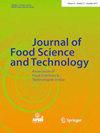产地和采收期对“苏里”梨皮在长期贮藏过程中的表面烫伤发生率和超微结构有影响
IF 3.3
3区 农林科学
Q2 FOOD SCIENCE & TECHNOLOGY
引用次数: 0
摘要
研究了产地和采收期对“苏里”梨在0℃贮藏期间表面烫伤发生率、果皮超微结构、果核褐变及相关物理品质的影响。“苏里”果实在中国山西省太古和临沂的五个不同日期采收,然后在0±0.5°C和85-90%的相对湿度下储存120或200天。贮藏120、200 d后检测表面烫伤。采收日期和产地对“苏里”果实表面烫伤的发生率和品质有显著影响。较早的收获时间与表面烫伤的发生率增加有关。临沂采摘的水果比太谷采摘的水果发生更严重的浅表烫伤。扫描电镜(SEM)显示,太谷果实贮藏后表皮和蜡层较临沂果实厚。采收较早的果实表面蜡质较少,开裂范围较广,果胶含量较低,果皮组织结构受损。“苏里”梨的浅表烫伤发生率取决于这些浅表层的超结构,差异可能由收获日期和地点驱动。本文章由计算机程序翻译,如有差异,请以英文原文为准。
Production area and harvest date influence superficial scald incidence and ultra-structure of 'Suli' pear skin during long term storage
The effect of production area and harvest date on the superficial scald incidence, ultra-structure of the pericarp, core browning, and related physical qualities of ‘Suli’ pears during storage period at 0 °C were investigated. ‘Suli’ fruits were harvested at Taigu and Linyi in Shanxi province of China over five different dates and then stored at 0±0.5 °C with 85-90% relative humidity for 120 or 200 days. Superficial scald was detected after 120 and 200 days of storage. Harvest date and production area significantly affected the incidence of superficial scald and the quality of ‘Suli’ fruits. Earlier harvest time was associated with increased incidence of superficial scald. Fruits picked at Linyi developed more severe superficial scald than fruits harvested at Taigu. Scanning electron microscope (SEM) revealed that the cuticle and wax layer of fruits from Taigu were thicker than those from Linyi after storage. The surface of earlier harvested fruits had less wax and more extensive cracking, lower pectin content, and damaged skin organization structure. The incidence of superficial scald in ‘Suli’ pears is dependent on the ultra-structure of these superficial layers, and differences may be driven by harvest date and location.
求助全文
通过发布文献求助,成功后即可免费获取论文全文。
去求助
来源期刊
CiteScore
7.70
自引率
0.00%
发文量
274
审稿时长
11 months
期刊介绍:
The Journal of Food Science and Technology (JFST) is the official publication of the Association of Food Scientists and Technologists of India (AFSTI). This monthly publishes peer-reviewed research papers and reviews in all branches of science, technology, packaging and engineering of foods and food products. Special emphasis is given to fundamental and applied research findings that have potential for enhancing product quality, extend shelf life of fresh and processed food products and improve process efficiency. Critical reviews on new perspectives in food handling and processing, innovative and emerging technologies and trends and future research in food products and food industry byproducts are also welcome. The journal also publishes book reviews relevant to all aspects of food science, technology and engineering.

 求助内容:
求助内容: 应助结果提醒方式:
应助结果提醒方式:


